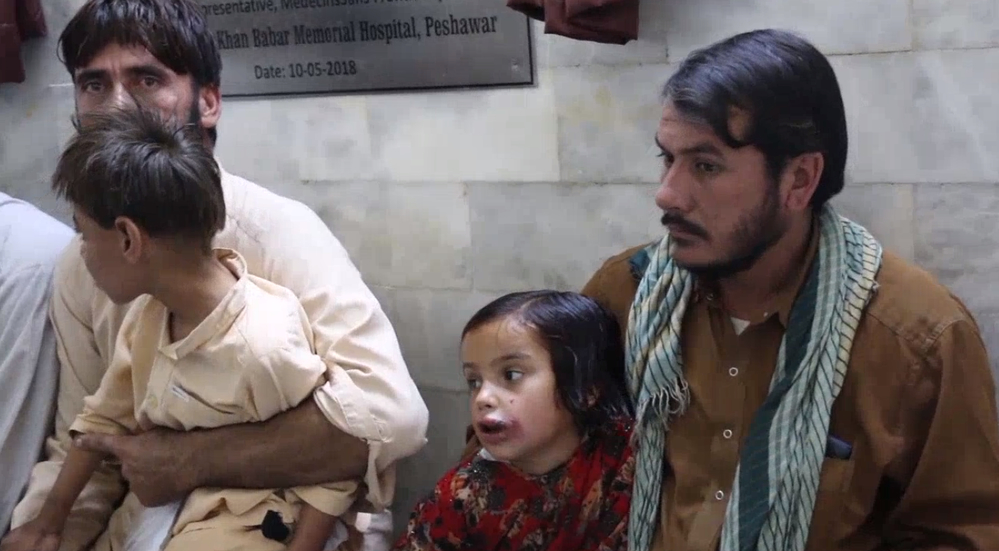In May, MSF opened a treatment centre for cutaneous leishmaniasis in Peshawar - its fourth in Pakistan.
Already, the centre has admitted more than 800 patients and is operating at full capacity, as are MSF’s three other treatment centres: two in Quetta and one in Kuchlak.
MSF is currently the biggest provider of treatment for the disease in Balochistan province, in the south of Pakistan. Meanwhile, in Khyber Pakhtunkhwa province, in the north, MSF’s Peshawar clinic is the only major centre providing free diagnosis and treatment for cutaneous leishmaniasis in the whole region.

MSF's cutaneous leishmaniasis project in Peshawar, Pakistan
In the waiting room of the Peshawar treatment centre sits Taj Bibi, whose entire family contracted cutaneous leishmaniasis after being bitten by sandflies, leaving them with painful skin lesions.
“My husband, my four sons and my older daughter were stung while working at a brick factory,” says Taj Bibi. “I was bitten by the sandfly at home, just like my youngest daughter, Zena. The environment we live in is dirty and there is no sanitation. Many of our neighbours and their children have been infected too.”

Why is cutaneous leishmaniais so hard to control?
The disease mainly affects people from rural areas, in places where living conditions are poor and clean water and sanitation almost non-existent. As a result, it is not generally seen as a public health priority.
Major challenges to controlling the disease in Pakistan are that there is a general lack of awareness about the disease, too few healthcare workers trained to deal with it, and no data collected at national level on its prevalence.
Added to this, the drugs to treat it are not widely available. The risk of shortage of the drug, that has to be imported, is a constant threat not only to the proper functioning of the treatment centers, such as MSF’s, but also to the health of people living with the disease.
When Taj Bibi was first diagnosed by a local doctor, she was told that no treatment existed in Pakistan.
Taj Bibi and her family – like so many of the patients who eventually arrive at MSF’s treatment centres – initially turned to the black market as no drugs were available in the public health facilities in the areas where MSF intervenes.
The drugs found on the black market are generally of poor quality or out of date, making them ineffective. This only adds to the suffering of people like Taj Bibi and her family, and increases their sense of neglect.

Physical and emotional scars
A serious consequence of this little-known disease is the psychological suffering that it creates. Its victims often feel excluded from their community because of the unsightly lesions it causes, and are left feeling rejected and ashamed.
Nabeela, aged 11, was taken out of school by her parents after she was bullied by classmates because of the lesions that covered much of her face.
“The other students constantly mocked her and isolated her,” says Nabeela’s father. “We ended up removing her from school.”
After treatment by MSF, her lesions have improved. “Previously there were lesions on the entire upper part of her face,” says her father. “Her treatment has removed some of them.”
Many girls affected by the disease fear that their lesions will dash their chances of getting married.

The disease also causes physical suffering and economic exclusion.
Taxi driver Saeepur Khan had to stop working because of the pain in his feet, leaving him with no way to earn a living – though he is hopeful that the treatment will allow him to work again soon.
Treating cutaneous leishmaniasis
The only drug currently available to treat cutaneous leishmaniasis is meglumine antimoniate, which must be injected either into the muscles or directly into the lesions for 20 to 35 days, depending on the severity of the infection.
Ten-year-old Sabit was infected with cutaneous leishmaniasis a year ago. He is now mid-way through a course of injections and well on the way to recovery. “The injections hurt, but I'm happy to finally be able to cure myself of this disease," says Sabit.

The influx of patients to the MSF treatment centres demonstrates the massive need for cutaneous leishmaniasis services across all affected areas. The disease affects hundreds of thousands of people, most of whom cannot afford treatment.






